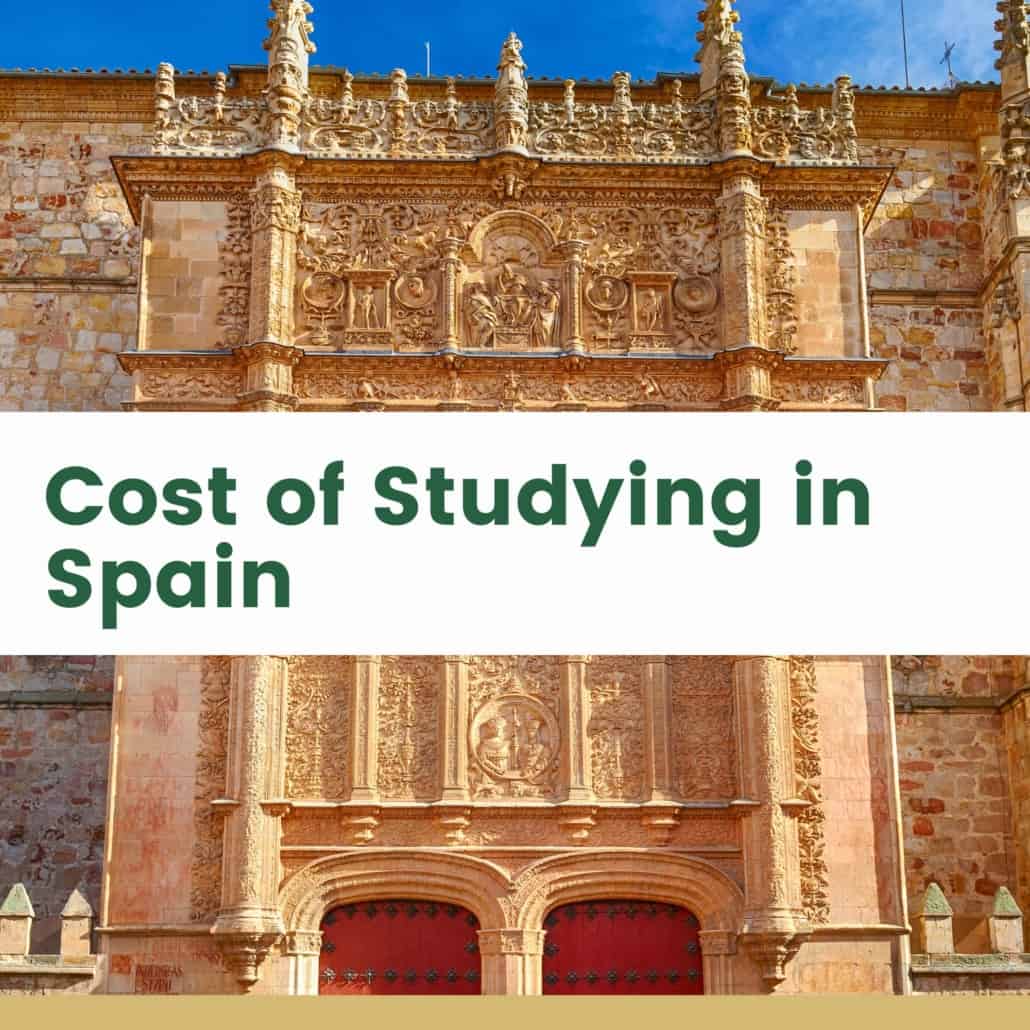Cost of Studying in Spain

Are you considering studying abroad in Spain? If so, you’ve come to the right place. With its vibrant culture, beautiful architecture, and unique cuisine, Spain is an incredibly popular study destination, but it can also be expensive. This post will explore the costs of studying in Spain, from tuition fees to living expenses. Whether you’re looking for a university experience on a budget or want to indulge yourself in luxury accommodation and cuisine, options fit any budget. Read on to discover more!
How Much Does It Cost to Study in Spain?
Studying in Spain is a great opportunity that can cost between 150 to 3,500 EUR/year, depending on the program. A Bachelor’s degree in Spain can cost relatively less, ranging from 150 to 3,500 EUR/year on average, whereas Master’s degree programs are slightly more expensive, coming in at 300 to 3,500 EUR/year.
Living costs will vary depending on lifestyle, so it’s important to factor them in. Fortunately for students looking to experience life abroad in Spain, there are options available that could make studying there much more affordable than originally thought.

Budget-Friendly Universities in Spain
Several universities in Spain offer competitive tuition rates and excellent education. Here are some of the best Spanish universities that offer study programs abroad at a fraction of the cost:
- International University of Catalonia
- University of Valencia
- University of the Balearic Islands
- University of A Coruña
- University of Granada
- University of Huelva
- Technical University of Valencia
- Autonomous University of Barcelona
- King Juan Carlos University
- University of Lleida
International University of Catalonia
The International University of Catalonia is one of Spain’s most popular universities for international students. This university offers various programs and degree levels at an affordable price, ranging from 4,500 to 10,320 EUR/year, depending on the program. It is also one of the few universities offering study abroad programs in various languages, including English and Spanish.
University of Valencia
The University of Valencia is one of the oldest universities in Spain and boasts a variety of study programs at different levels, from undergraduate to postgraduate. This university offers competitive tuition rates, ranging from 578 to 1,178 EUR/year, depending on the program. It is also the only university in Spain that offers specialized programs in International Relations and Global Studies.
University of the Balearic Islands
University of the Balearic Islands is one of the most affordable universities in Spain. This university offers a variety of undergraduate and postgraduate programs, ranging from 610 to 1,801 EUR/year, depending on the program. It also offers several exchange programs for international students, allowing them to study in Spain for a fraction of the cost.
University of A Coruña
University of A Coruña is a great choice for anyone looking to study in Spain on a budget. This university offers competitive tuition rates, ranging from 736 to 1,044 EUR/year, depending on the program. Additionally, it offers several exchange programs for international students and is known for its friendly atmosphere and welcoming staff.
University of Granada
The University of Granada is another affordable university in Spain. This university offers a variety of programs and degree levels at competitive rates, ranging from 578 to 1,178 EUR/year, depending on the program. It is also known for its diversity and inclusivity, making it a popular destination for international students looking to experience life in Spain.
University of Huelva
The University of Huelva is a great choice for students looking to experience life in Spain without breaking the bank. This university offers a variety of programs and degree levels at competitive rates, ranging from 578 to 1,178 EUR/year, depending on the program. It also offers several exchange programs for international students and is known for its warm climate and stunning scenery.
Technical University of Valencia
The Technical University of Valencia is a great choice for students looking to study in Spain at an affordable price. This university offers competitive tuition rates, ranging from 682 to 1,469 EUR/year, depending on the program. It is also known for its excellent education and research opportunities in engineering and related fields.
Autonomous University of Barcelona
The Autonomous University of Barcelona is one of the most prestigious universities in Spain and offers a variety of programs and degree levels at an affordable price. This university offers competitive tuition rates, ranging from 937 to 1,758 EUR/year, depending on the program. It is also renowned for its diverse student body, with students from around the world studying at this institution.
King Juan Carlos University
King Juan Carlos University is one of the top universities in Spain and offers a variety of programs and degree levels at an affordable price. This university offers competitive tuition rates, ranging from 578 to 1,178 EUR/year, depending on the program. It also offers several exchange programs for international students and is known for its friendly atmosphere and welcoming staff.
University of Lleida
The University of Lleida is a great choice for students looking to experience life in Spain without breaking the bank. This university offers competitive tuition rates, ranging from 578 to 1,178 EUR/year, depending on the program. Additionally, it offers several exchange programs for international students and is known for its stunning scenery, vibrant culture, and welcoming atmosphere.
These are just a few of the many affordable universities in Spain. With many options available, students can find an institution that meets their academic and financial needs. So, if you want to study in Spain without breaking the bank, consider one of these affordable universities!

Why Should You Study In Spain?
Spain is a great place to study for students from around the world. It offers an excellent education, diverse culture, and beautiful landscapes. Additionally, there are a variety of affordable universities in Spain that offer competitive tuition rates, exchange programs, and other opportunities for international students. Spain is known for its friendly people, delicious food, and vibrant atmosphere. So, if you’re looking for an exciting and rewarding experience while earning your degree abroad, consider studying in Spain!
Bottom Line
Studying in Spain can be a great opportunity to experience life abroad. Spain is a great choice for any budget with its beautiful scenery, unique culture, and competitive tuition. There are several universities in Spain that offer study programs at competitive prices, so make sure to check them out before making a decision.



 Spain is known for its beautiful weather, stunning architecture, and delicious food. However, it is also the location of some of the world’s top colleges. Spain should be at the top of your list if you’re looking for quality education. In this blog post, we’ll take a closer look at some of the best universities in Spain and what they have to offer. So read on to learn more!
Spain is known for its beautiful weather, stunning architecture, and delicious food. However, it is also the location of some of the world’s top colleges. Spain should be at the top of your list if you’re looking for quality education. In this blog post, we’ll take a closer look at some of the best universities in Spain and what they have to offer. So read on to learn more!
